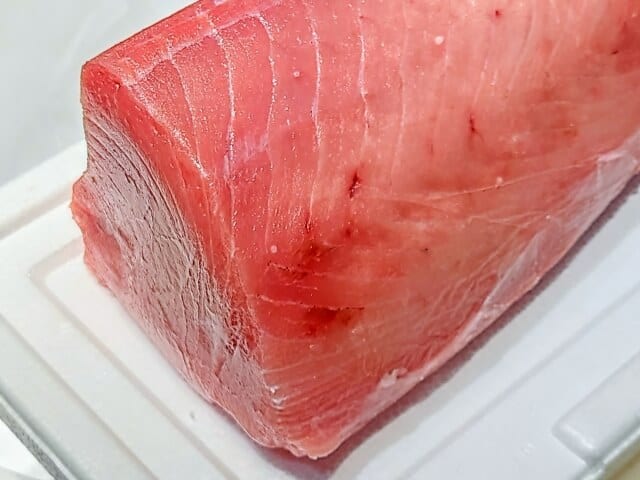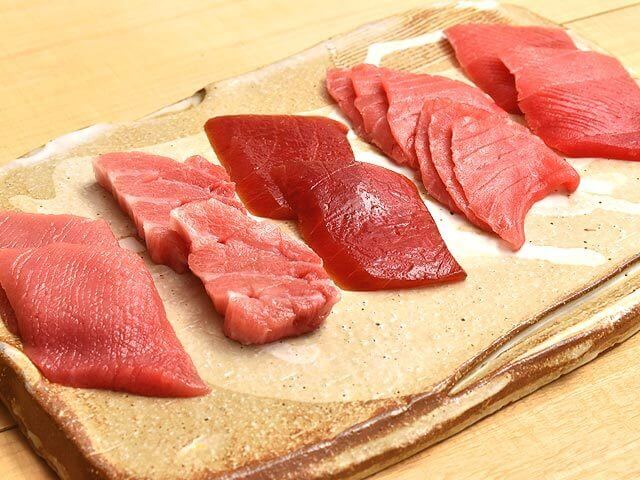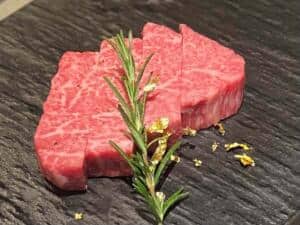It goes without saying that Japan is a major consumer of tuna. Approximately 2 million tons of tuna are caught worldwide each year, and in fact, approximately 1/4 of that are Japanese. Maguro is highly regarded for its flavor, texture, and versatility in sushi and sashimi, and it’s a staple in Japanese cuisine. There are even different species of tuna used, with bluefin tuna (hon-maguro) being one of the most sought-after and prized for its quality. As we go along in this article, you will see the charms of Maguro sushi.
What is Maguro sushi?

Maguro sushi in Japan refers to sushi made with maguro, which is the Japanese term for tuna. Maguro is a popular and widely consumed type of sushi. Red tuna, medium fatty tuna, and large fatty tuna are classic sushi ingredients. Locals serve Maguro sushi in various forms, including Nigiri sushi, where a slice of maguro is on a small bed of seasoned rice and often topped with a small dab of wasabi, and Sashimi, where thin slices of tuna are served without rice.
Maguro sushi History

The history of tuna in Japan is a fascinating journey that stretches back to ancient times. Tuna consumption in Japan dates all the way back to the Jomon period, over 10,000 years BC. It’s intriguing to ponder how the people of that era managed to catch and consume such large tuna. Over the course of history, tuna eating customs evolved from the Jomon period through the Yayoi, Asuka, Nara, Heian, and Kamakura periods, and even into the Reiwa period. However, tuna was not always as popular as it is today. There was a time when it was considered an unlucky fish and not a delicacy for the common people. Tuna’s quick spoilage after being caught, coupled with limited methods for preserving it in a time before advanced refrigeration technology, made it a challenging fish to incorporate into the diet.
The turning point in the history of tuna consumption in Japan occurred during the Edo period. It was during this time that the food culture changed, soy sauce production began in the Kanto region, and tuna was preserved through marination in soy sauce. Pickled tuna gained popularity due to its delicious taste. Sushi restaurants were becoming increasingly common, and sushi’s accessibility and quick serving style contributed to its popularity. At these early sushi restaurants, they often pickled tuna and served as nigiri. The fatty parts of the fish were often discarded or left unused because they were considered too greasy and difficult to store. However, in the Showa era, around the 1960s, fatty tuna (Toro) began to be appreciated and consumed. Improved refrigeration technology, growing demand for tuna, and the limited quantity of fatty tuna available from each fish all contributed to its rise in popularity.
Key points when choosing delicious Tuna

When determining the quality of tuna, consider these four key factors. First, examine its color; ideally, it should be a vibrant red or pink. Fresh tuna boasts this hue, while a loss of freshness can lead to a slightly blackish or whitish appearance. Furthermore, transparency and glossiness are additional indicators of delicious tuna, so comparing these traits can be helpful.
When purchasing tuna with visible veins, opt for cuts with thin streaks running parallel (or diagonally) to the grain. Slicing sashimi with the sinew and knife perpendicular to each other results in a pleasing texture. If parallel lines are not available, diagonal ones are a good alternative. Avoid selecting tuna with black or red spots, as these indicate blood clots, a sign of improper draining that can cause a fishy odor and damage. Lastly, inspect the tray for any red juices, known as drips, as they signify the loss of flavor components and nutrients during thawing. Older tuna is more likely to drip, resulting in decreased taste and freshness.
Types of Tuna Japanese consumed

Bluefin Tuna
Bluefin tuna, often referred to as the king of the tuna world. Known for its large size, shiny black body, and high market value. Bluefin tuna is especially popular during the winter, prized for its bright red flesh and rich flavor. It’s commonly served as sashimi or sushi.
Bluefin Tuna Price
Southern Bluefin Tuna
Southern bluefin tuna is caught in the South Atlantic Ocean and is considered a high-quality fish similar to bluefin tuna. Known for its rich, sweet taste and fatty flesh. While it’s commonly enjoyed as sashimi and sushi during the summer season, farming has made it available year-round.
Southern Bluefin Tuna Price
Bigeye Tuna
Bigeye tuna, also known as “Bachi tuna,” is a medium-sized species with a bright pink color and a refreshing taste. The Bigeye tuna is less fatty than bluefin and southern bluefin tuna and often enjoyed as sashimi or steak, as it’s not ideal for sashimi due to its texture.
Bigeya Tuna Price
Yellowfin Tuna
Yellowfin tuna is popular by its yellowish appearance and lean, firm flesh. Due to its firm texture, it’s commonly used for sashimi and sushi, retaining its shape well. Yellowfin tuna is low in fat and used in canned foods.
Yellowfin Tina Price
Albacore Tuna
Albacore tuna is a smaller species of tuna, primarily found in tropical and temperate waters worldwide. It has a soft texture, pink flesh, and a whitish color overall. It’s often mistaken for fatty tuna, but it isn’t actually fatty.
Albacore Tuna Price
By the way, the average wholesale price of frozen bluefin tuna at the Tokyo Central Wholesale Market in 2020 was ¥2,948, ¥1,734 for southern bluefin tuna, ¥941 for bigeye tuna, and ¥888 for yellowfin tuna. In particular, the wholesale price of bluefin tuna and southern bluefin tuna fluctuates greatly depending on the season and other factors.
Japan ranks third in tuna catch

Japan ranks third in the world in tuna catch and it not only consumes tuna but also ranks third in the world in terms of catch. As tuna is a migratory fish, you can catch it in oceans around the world, and Japan is the country with the third largest catch, following Indonesia in first place and Taiwan in second place. Most of the tuna caught in the waters around Japan are bluefin tuna and albacore tuna, and recently.
Maguro sushi FAQ
- Is Maguro Sushi Safe to Eat Raw?
-
Maguro sushi is typically safe to eat raw when it has been properly handled, prepared, and stored under sanitary conditions. In Japan, sushi chefs are trained to adhere to strict food safety standards to minimize the risk of foodborne illnesses associated with consuming raw fish.
- What are the dipping sauce great for pairing with Maguro Sushi?
-
In Japan, locals often enjoy maguro sushi with traditional condiments and side dishes. These accompaniments include soy sauce (shoyu), wasabi, pickled ginger (gari), and miso soup. Soy sauce is lightly applied to the fish side of the sushi, while wasabi is used sparingly for added flavor. Pickled ginger serves as a palate cleanser between sushi pieces, and miso soup complements the sushi with its savory umami-rich broth.
Maguro sushi Recipe
Maguro sushi Ingredients
| Ingredients of Maguro sushi for 2 persons | Measurements |
|---|---|
| Tuna | 200g |
| Cooked rice | 50g |
| Sushi vinegar | 14g |
| Wasabi | 1g |
How to make Maguro sushi?
Sprinkle sushi vinegar over the rice and mix with a rice scoop. Fan it with a fan to cool it to the skin.
Cut the tuna into bite-sized pieces. Wet your hands with vinegar and squeeze 1 into a bite size.
Spread a little wasabi on the tuna and place it on bowl. Then serve.
Where to buy Maguro sushi?
Sushi Fukuzuka (すし ふくづか)

“Sushi Fukuzuka”, which opened in a back alley in Kagurazaka in March 2018, is a new restaurant where you can enjoy “tuna” to your heart’s content, the cornerstone of any sushi restaurant. They serve 5 pieces of sashimi in the course – “Senanaka Toro”, “Back Kiwatoro”, “Zuke”, “Haradaitoro” , Hatara Naka Toro”.
Sushi Takashi (寿司孝)

This is a very popular restaurant where you can enjoy tuna. You can have each part of the fish made to your liking, such as lean, medium fatty, or fatty fatty, or you can enjoy seasonal fish as well! With a wide range of courses available, it is ideal for banquets and entertainment.
Tasuke Sushi Asakusa (太助寿し 浅草)

Tasuke Sushi, which has seats on the first floor at the counter made from a stately 200-year-old Japanese cypress tree, and elegant table seats in the new building on the second floor, mainly serves Oma’s bluefin tuna, is the best tuna in Japan. What’s amazing about the tuna here is the sticky texture that comes from high-quality fat!
Takeaway

From the history of tuna consumption to the precise techniques used in its preparation, maguro sushi showcases the rich tapestry of Japanese gastronomy. By understanding the nuances of enjoying this iconic dish, you’ve gained insights into the culture and traditions that surround it. Next time you savor a piece of maguro sushi, you can do so with a deeper appreciation for the flavors,
You can check some Japanese sushi dishes that we know you would like to try too.
















Comments